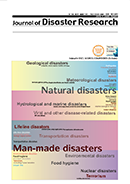18 巻, 6 号
選択された号の論文の15件中1~15を表示しています
- |<
- <
- 1
- >
- >|
Special Issue on the 100th Anniversary of the Great Kanto Earthquake
-
原稿種別: Editorial
2023 年18 巻6 号 p. 553-554
発行日: 2023/09/01
公開日: 2023/09/01
PDF形式でダウンロード (115K) -
原稿種別: Material
2023 年18 巻6 号 p. 555-557
発行日: 2023/09/01
公開日: 2023/09/01
PDF形式でダウンロード (787K) -
原稿種別: Material
2023 年18 巻6 号 p. 558-561
発行日: 2023/09/01
公開日: 2023/09/01
PDF形式でダウンロード (1897K) -
原稿種別: Material
2023 年18 巻6 号 p. 562-565
発行日: 2023/09/01
公開日: 2023/09/01
PDF形式でダウンロード (715K) -
原稿種別: Material
2023 年18 巻6 号 p. 566-569
発行日: 2023/09/01
公開日: 2023/09/01
PDF形式でダウンロード (1902K) -
原稿種別: Review
2023 年18 巻6 号 p. 570-577
発行日: 2023/09/01
公開日: 2023/09/01
PDF形式でダウンロード (3621K) -
原稿種別: Survey Report
2023 年18 巻6 号 p. 578-589
発行日: 2023/09/01
公開日: 2023/09/01
PDF形式でダウンロード (3514K) -
原稿種別: Paper
2023 年18 巻6 号 p. 590-597
発行日: 2023/09/01
公開日: 2023/09/01
PDF形式でダウンロード (2000K) -
原稿種別: Paper
2023 年18 巻6 号 p. 598-610
発行日: 2023/09/01
公開日: 2023/09/01
PDF形式でダウンロード (2330K) -
原稿種別: Paper
2023 年18 巻6 号 p. 611-631
発行日: 2023/09/01
公開日: 2023/09/01
PDF形式でダウンロード (4944K) -
原稿種別: Paper
2023 年18 巻6 号 p. 632-648
発行日: 2023/09/01
公開日: 2023/09/01
PDF形式でダウンロード (1264K) -
原稿種別: Review
2023 年18 巻6 号 p. 649-655
発行日: 2023/09/01
公開日: 2023/09/01
PDF形式でダウンロード (670K) -
原稿種別: Paper
2023 年18 巻6 号 p. 656-665
発行日: 2023/09/01
公開日: 2023/09/01
PDF形式でダウンロード (398K) -
原稿種別: Paper
2023 年18 巻6 号 p. 666-673
発行日: 2023/09/01
公開日: 2023/09/01
PDF形式でダウンロード (1292K) -
原稿種別: Note
2023 年18 巻6 号 p. 674-677
発行日: 2023/09/01
公開日: 2023/09/01
PDF形式でダウンロード (391K)
- |<
- <
- 1
- >
- >|
